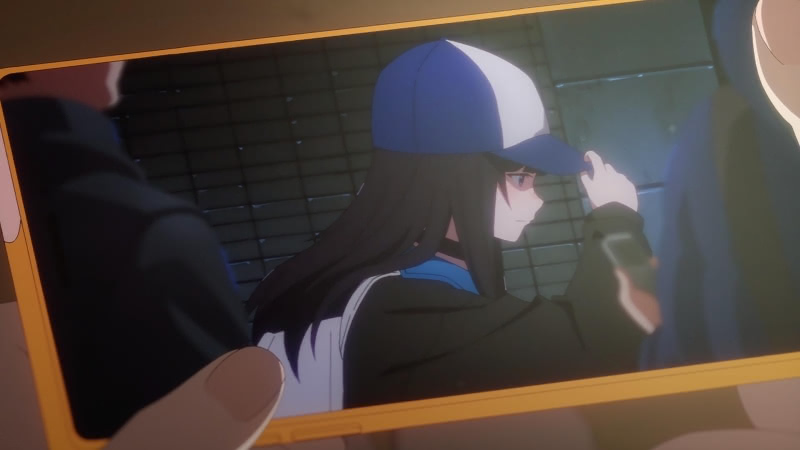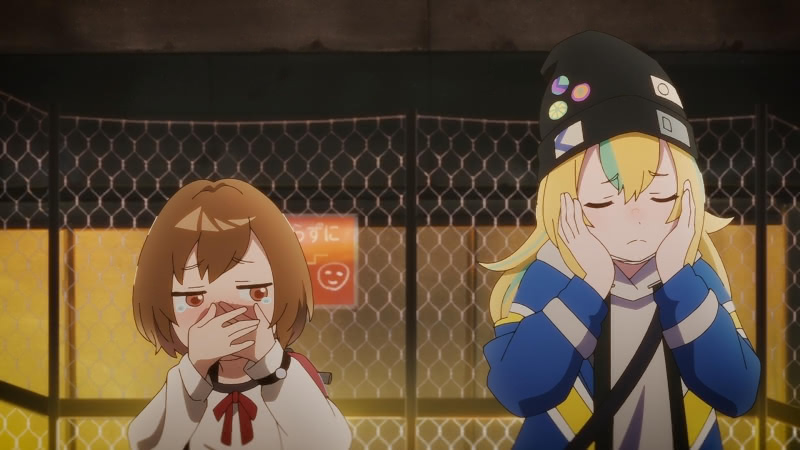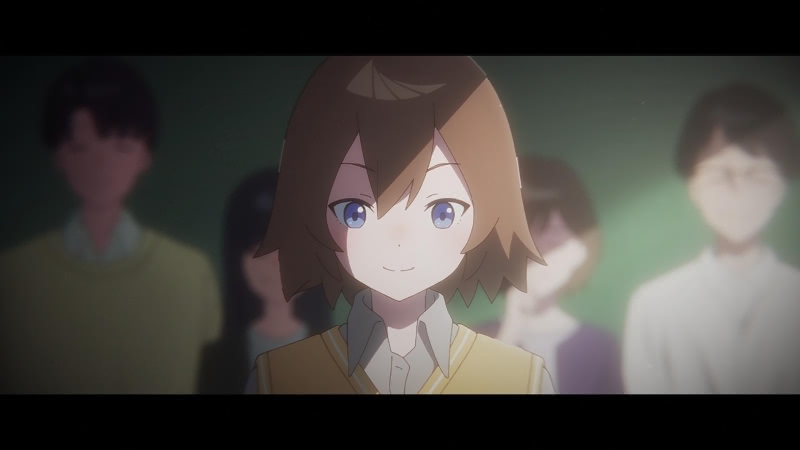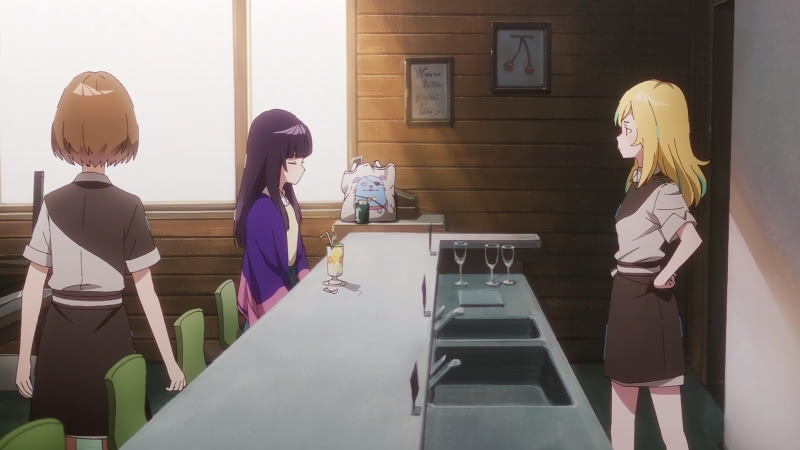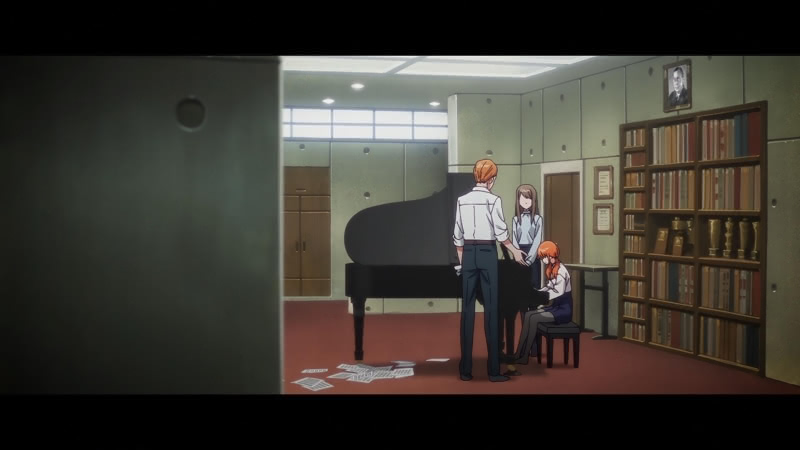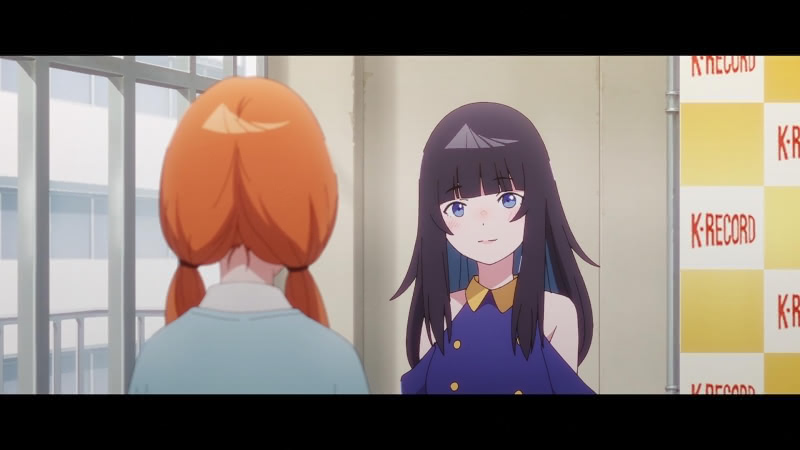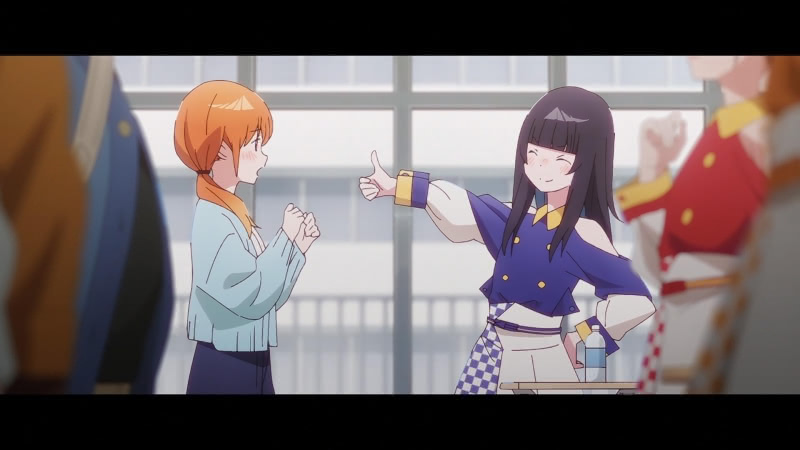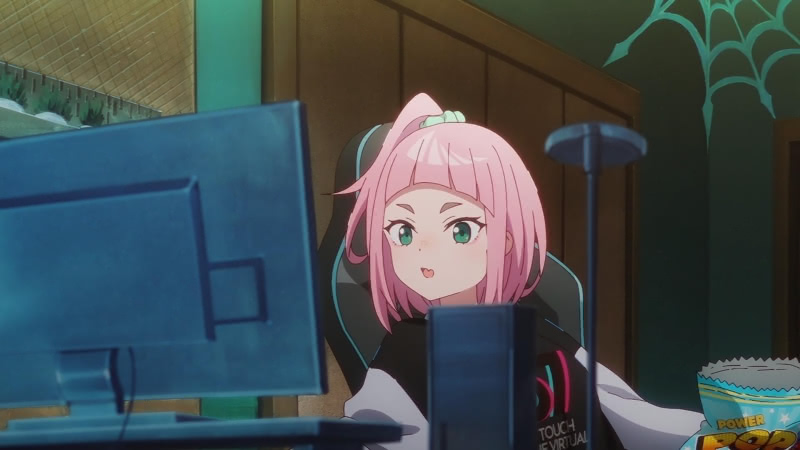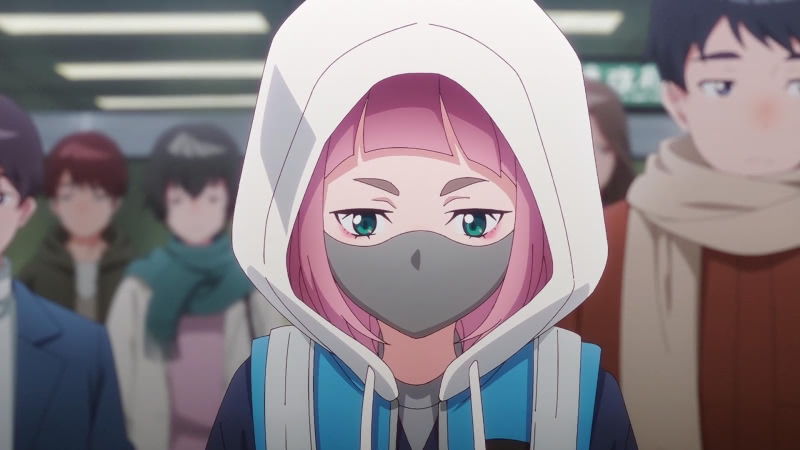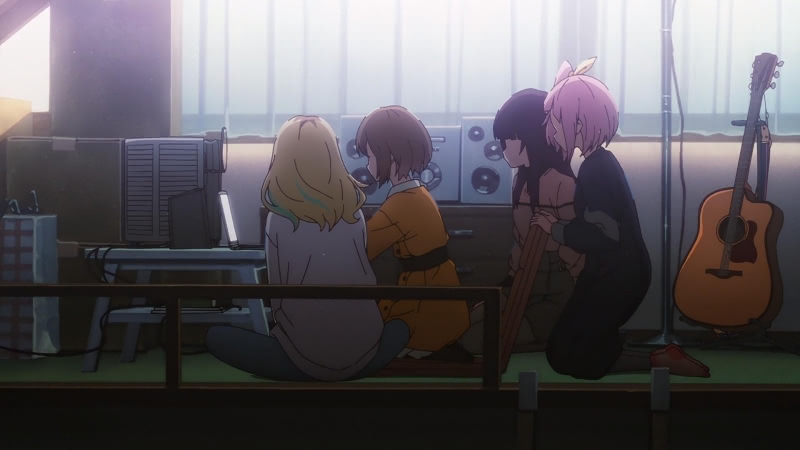Jellyfish Can’t Swim in the Night is an original anime series produced by Doga Kobo which began airing on April 7, 2024. Nine episodes have aired as of the original publication date of the instant article. Regular New Leaf Journal readers will know that I write regularly about interpreting hair color in anime. Jellyfish Can’t Swim in the Night foreshadows colorful changing hair themes in its opening song animation and then delivers on its thematic promise in its early episodes. After a brief series introduction, your resident 2D person hair color anthropologist will tackle the gradients of three of the four main characters and one secondary character of this spring 2024 anime series.
(See my full collection of posts on hair color in Japanese anime, manga, novels, and games.)
A Note on Spoilers
After providing a very short introduction to Jellyfish Can’t Swin in the Night, I will not discuss the plot of the show more than what is necessary to discuss the hair color of three characters. As a result, I will focus almost exclusively on episodes 1, 2, 3, 5, and 9. I think that this review is safe for people who have not watched the show and who may be inclined to do so in the future (it may even give you an idea of whether the show is of any interest). However, I will note for the sake of caution that my spoiler-lite review will divulge some significant details about the backstories of three of the main characters but, with that one exception, all of these details come from the first three episodes.
General Introduction to the Series
I explained in my first anime hair color article that the initial step to understanding hair color in anime is to understand the world the anime is set in.
Jellyfish is set in Tokyo’s Shibuya ward. It has a modern, real-world setting with no magical or extraterrestrial elements. While many anime series with real-world settings employ unnatural hair colors without explanation, understanding that the show has a real-world setting is still a good starting point.
Before continuing – note that the first four girls I will discuss are all about the same age (high school seniors).
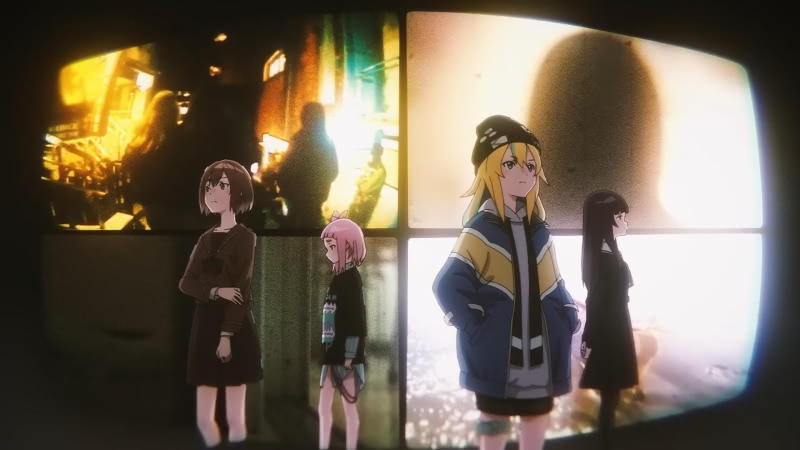
The principal, albeit not exclusive, view-point character is a brown-haired high school senior named Mahiru Kouzuki. She is the most normal and well-adjusted member of the cast and the team’s (the team will come into focus shortly) resident artist. Mahiru won an art contest when she was younger and, as a result, has her original jellyfish mural featured on a wall in Shibuya. However, Mahiru’s friends (not knowing that Mahiru was the artist) called the mural weird – causing Mahiru to doubt herself and take a break from drawing. Mahiru has brown hair and, as we will see, appears to have always had brown hair – meaning that she will be less the focus of this article than she is of the anime since the show (A) leads us to believe that her apparently brown hair is her natural hair color and (B) nothing happens to suggest that anyone thinks Mahiru’s brown hair is unusual.
Mahiru’s life changes when she meets a former idol (then known as “Nonoka”) named Kano Yamanouchi. Kano happens to be a fan of a mural Mahiru drew when she was younger (prior to their meeting), and she ropes Mahiru into her project to become an anonymous music star as a “VTuber” — the show’s YouTube substitute. When we meet Kano, she has blonde-yellow hair with blue highlights.
Kano next ropes in a girl named Mei Kim Anouk Takanashi. Mei goes to a school which specializes in music and is studying the piano. She is a super-fan (to the point of being slightly creepy) of “Nonoka” from Kano’s prior life as a professional idol. Mei has long, straight, black hair when we meet her.
The final member of Kano’s project is Kiui Watase, who is a childhood friend of Mahiru. Kiui is a popular Vtuber who streams video games and talks to her friends. Kiui has short pink hair when she first appears in the show.
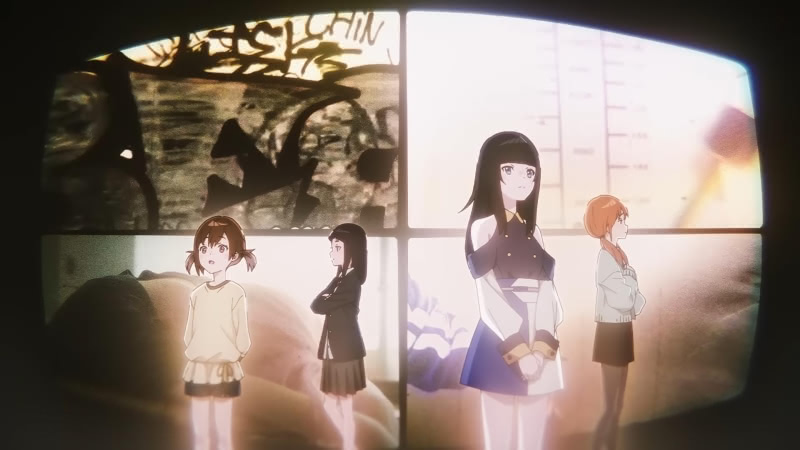
This article is not about the plot Jellyfish Can’t Swim in the Night, but I will submit for the record that I have mixed feelings about the show through nine episodes. It has strong production values and polish – fittingly for studio Doga Kobo’s 50th anniversary work. The show’s heart is in the right place and with the qualified exception of Mei, the main characters are solid. But it lacks focus, sometimes spending too much time on uninteresting character arcs and other times rushing through key points about trying to become a successful Vtuber that merit more attention in a show that presents a character’s efforts to become a successful Vtuber as a key plot point.
But while I think the show as a whole is hit or miss, we will see that it is one of the better recent anime for the study of 2D hair color.
Hair Color of Kano Yamanouchi
I had been meaning to write this article for several weeks since most of the show’s major hair color revelations were delivered by the end of episode 4. My delays turned out to be fortuitous for in the case of Kano Yamanouchi there was more to her hair color history than I had first believed.
We meet Kano with her bleached blonde hair with blue-ish highlights. She is presented as a free-spirit and her past as a former idol is revealed very shortly after her introduction. Jellyfish’s opening song visuals strongly suggested that hair color would be noted in this show – but even without that clue one could reasonably conclude than Kano was dying her hair.
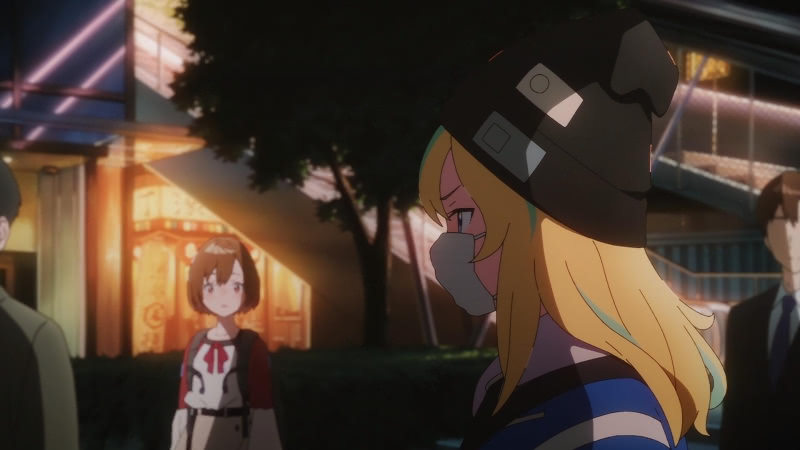
Fortunately for our hair color studies, we did not have to rely on the theme song for Kano beyond episode one. Mahiru learns independently that Kano is a former idol and looks up a video of Kano from her past idol days.
Kano as an idol had black hair. She was forced to quit being an idol on account of a scandal (not the stereotypical Japanese idol scandal in her case, but that is beyond our scope). What is significant for our purposes is that Kano had black hair when she was an idol and clearly changed her hair color after leaving the industry. There are a number of scenes flashing back to Kano’s idol days in later episodes, and she has black hair in all of them – so we can consider that duly established
Before continuing, I will note a fun scene in the first episode in which Kano reveals to Mahiru that she used to be an idol but before Mahiru conducts basic internet sleuthing. Mahiru gives Kano a close look and states that she could see Kano being an idol with a delinquent vibe (we have seen the “delinquent” quip applied to hair color in A Dream of Summer and A Sign of Affection). To be sure – this was likely in reference to Kano’s clothes and manner – not just her hair, but one can imagine her hair playing a role in Mahiru’s assessment. Kano pinches Mahiru’s nose and assures Mahiru that she played the part of a delinquent when she was an idol. Moreover, Kano includes “black hair” on the list of qualities she had as an idol to fit the part. That is a perfect segue to our next revelation.
(Although it is not explicitly stated, Kano’s intricate hair dye job , in my independent opinion, is obviously been inspired by Mahiru’s jellyfish mural. I suspect that Mahiru’s failure to notice this prompted Kano’s decision to administer corporal punishment in the form of playful nose pinching.)
I assumed that Kano’s hair is naturally black. However, I was disabused of this assumption in episode 9.
Pictured above is Kano before she became an idol. The young Kano’s hair is not black, but brown. It was possible, of course,that the earnest young Kano dyed her hair brown as a little girl only to have it revert to natural black when she became an idol. This late reveal is notable in that it is the only main character hair color change not depicted in the theme song animation. Jellyfish was not content to leave us with even the slightest sliver of doubt. We are treated to another flash-back scene early in episode 9 showing Kano, before she made her debut as an idol, having her hair dyed from her natural brown to black.
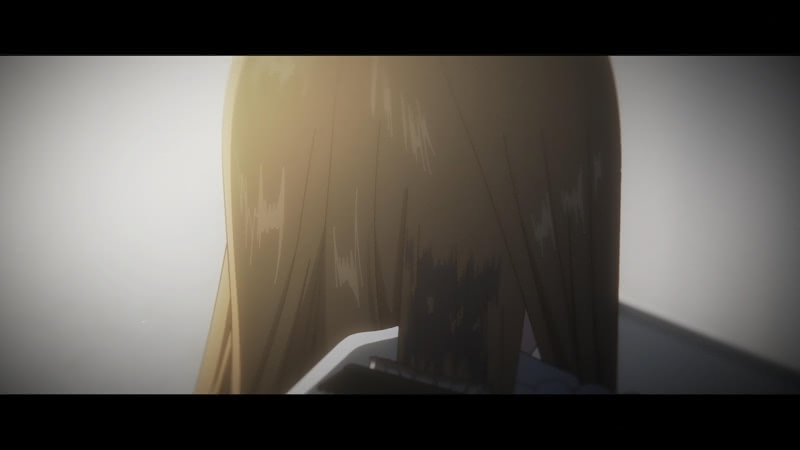
Kano has almost as many wholesale hair color changes on her record as she has gradients in her current, Mahiru-jellyfish-inspired style.
(Note: There is possible significance to Kano’s hair being dyed black before becoming an idol but it is speculative and beyond our scope for mild spoiler reasons, so I will set it aside for this article while noting it for people watching the show.)
Kano’s hair color history is so well-established that we could overlook two points of reference from her family. First, Kano’s older sister has golden brown hair which, while not identical to Kano’s natural brown hair color, is close enough that one could not safely conclude that it must be the result of hair dye (granting I would err on the side of guessing that there is hair dye involved).
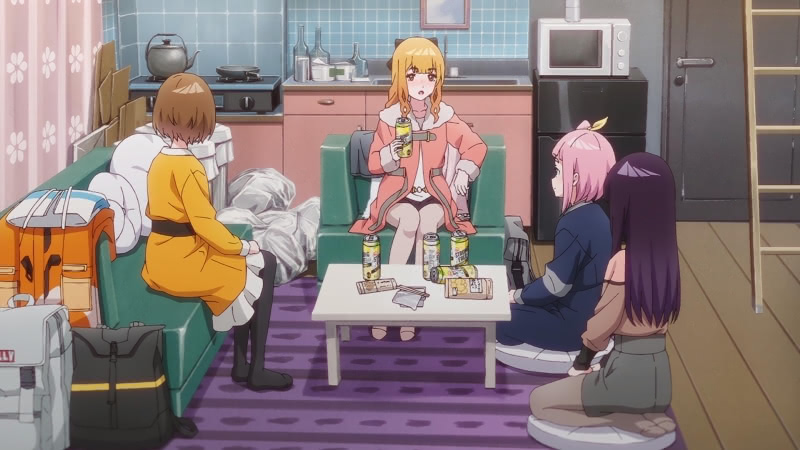
I will tell you, rather than show you, about Kano’s mother. Kano’s mother has black hair. I will note that when Kano’s mother is first pictured, viewers have reason to believe that Kano’s natural hair color is black and thus close to identical to her mother’s hair color. The natural assumption would be that Kano’s sister is almost certainly dying her hair. However, as we learn later, Kano’s natural hair color is actually closer to that of her sister. While this does not prove that Kano’s mother is dying her own hair black (I will note that Kano’s father has not been pictured as of episode 9), it certainly leads one to consider the possibility.
(I decided not to show Kano’s mother, despite the fact her mother is pictured early in the show, because one look at Kano’s mother makes her role in the story obvious in context. Since Kano’s mother is not necessary to establish Kano’s hair color journey, I decided to refrain from making an unnecessary reveal.)
One character does explicitly comment on Kano’s current eye-catching hair. When a former fan of “Nonoka” the idol tracks Kano down and and learns that Kano does not plan to try to return to her former idol personality, she immediately declares it unacceptable that Kano’s former “tasteful black locks” are now bleached (per HiDive’s translation). That girl is none other than Mei Kim Anouk Takanashi, who, as we will see, has her own hair color story.
Mei Takanashi
While Kano’s hair color journey has the most twists and turns, no one’s hair color is more significant to her story than Kano’s super-fan, Mei Takanashi. We meet Mei with long, black hair.
However, we see in screenshots that Mei’s natural hair color is not black at all. In fact its a sort of auburn,
Lest one were to think that Mei was dying her hair auburn only to let it return to black, we see that auburn is, in fact, her natural hair color. Firstly, her father when shown from the back in a flash-back has Mei’s auburn hair color. Second, her auburn hair contributed to her being ostracized in school, suggesting that it was not a burden she took on by choice. In one scene, we see Mei’s classmates state that they wish they could dye their hair too, and then exit the scene before Mei could tell them that auburn is her unusual hair color .
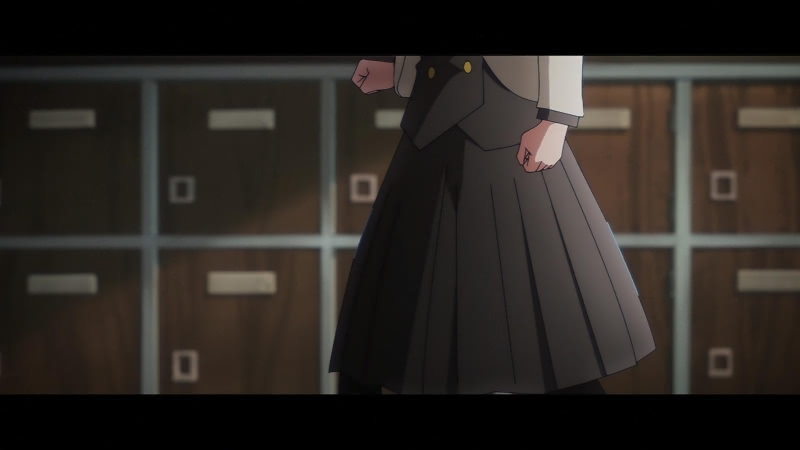
The show could have left us to fill in the blanks about Mei, but as was the case was Mei’s hero, Kano, it was not content to do so. Mei’s life changed when she talked to then idol Kano at a meet-and-greet.
Mei had not been a fan of Nonoka going into the meet-and-greet. However, an obsession was born when Nonoka/ Kano – praised Mei’s name, called her hair awesome, and promised to go watch her play piano one day.
We see in a flashback scene that Mei asked her salon to give her the same hair color and style as “Nonoka.”
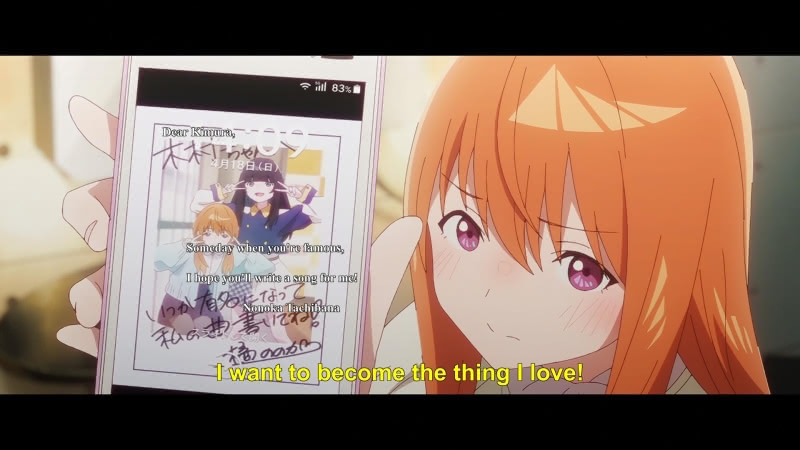
Mei’s hair color change to black played an extra role in the second episode – it explained why Kano did not (initially, at least) recognize her long-time fan.
A Note On Mahiru
I noted in the general introduction that I would not write much about Mahiru despite the fact that she is the main view-point character and the co-main character in the series along-side Kano. Mahiru is depicted with brown hair as a high school senior and is shown to have had the same hair color as a kid. Moreover, her sister shares her brown hair. These points combined with the fact that no one comments on Mahiru’s hair and there is nothing we are shown about Mahiru to suggest that she is dying her hair leads one to believe her brown hair is natural.
Brown hair in anime can sometimes be tricky. In addition to the fact that there are real-world stories of Japanese students with naturally brown hair being wrongly suspected of coloring their hair or otherwise being singled out for mistreatment, we have seen cases of anime where brown hair has been commented on or alluded to. For example, I discussed the cases of Iroha Isshiki in My Teen Romantic Comedy SNAFU and Anna Nagumo in Ippon! Again who were noted to have naturally brown hair despite being Japanese (the Iroha note comes from the underlying novel series). Conversely, we saw in The Girl I Like Forget Her Glasses that the middle school male lead of the show, Kaede Komura, was dying his black hair brown (at the behest of his mother, surprisingly enough). However, we studied one case where Kaori Orimoto, a character from My Teen Romantic Comedy SNAFU, was canonically depicted with black hair in the underlying novel series before being given brown hair in the anime adaptation. Yuki Itose from A Sign of Affection is depicted as having naturally brown hair before dying her hair a shade of strawberry blonde. In other cases – such as that of Mahiru in Jellyfish, brown hair is accepted as natural without comment. See for example Kaede’s love interest in The Girl I Like Forgot Her Glasses. Ai Mie.
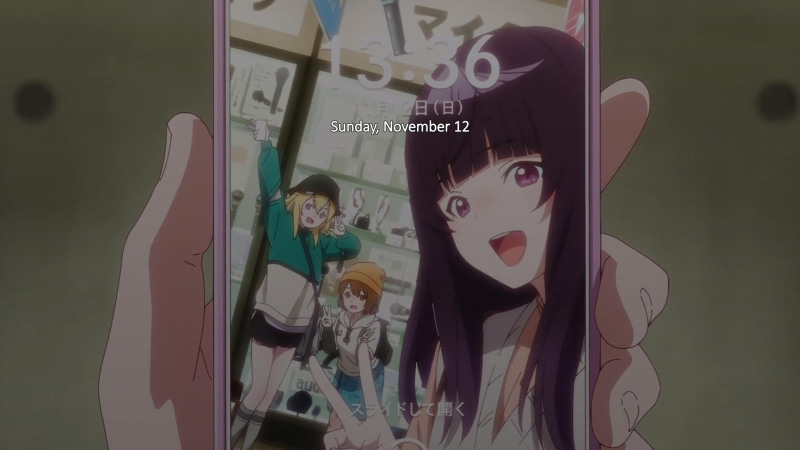
While we did not need additional evidence to reach our conclusion about Mahiru’s hair, we can understand the Kano and Mei stories as presenting some additional evidence. Young Kano’s natural hair color is similar to Mahiru’s, showing us another case of an important character having natural brown hair that is not close to black. In noting that no one comments on Mahiru’s hair, Mei provides useful contrast. Both Kano and Mahiru have medium-brown hair. Mei’s auburn hair is clearly distinguishable and it stands out much more from the other characters we see in the show than does Mahiru’s.
Kiui Watase
Kiui Watase is most commonly seen in her dark bedroom with messy pink hair. While she is on screen early in the show, her episode comes after Kano’s and Mei’s. With hair dye well-established in the show’s world and with there being some obvious clues about Kiui’s current situation, one could conclude with near absolute certainty that Kiui is not one of the rare naturally bright-pink haired people.
Sure enough, we see in a flashback to Kiui’s childhood with Mahiru that she has naturally black hair – similar, in fact, to the currently dyed hair of Mei and the former black hair of idol-Kana.
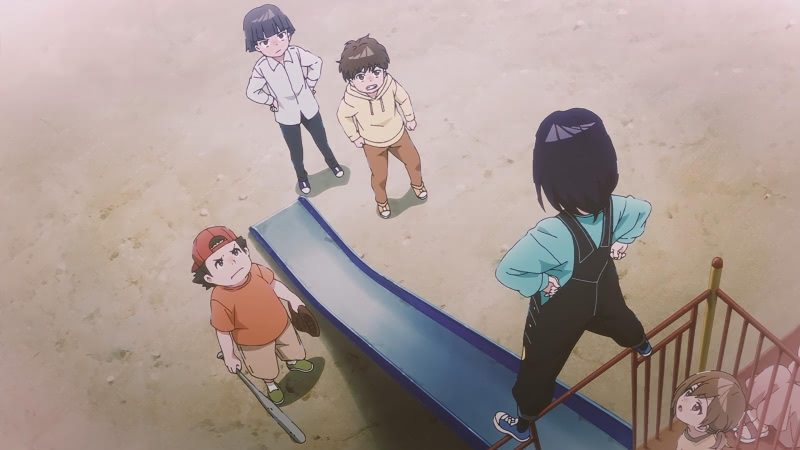
Kiui’s dramatic hair color change ties into her going from pretending to be a super-hero in front of a dazzled Kana as a child to now spending a great deal of time working as a VTuber from her bedroom. But the particulars are a bit beyond our scope and we do not see the moment Kiui’s hair color changed like we did with Kana and Mei. I will note one example in episode 3 of Kiui’s acknowledging one consequence of dying her hair:
When she goes out she covers her hair with a hoodie – presumably to avoid the possibility that someone she knows would recognize her.
To Kiui’s surprise, both Kana and Mei are immediately fond of Kiui’s hair – which causes her to blush and remove her hoodie when they meet.
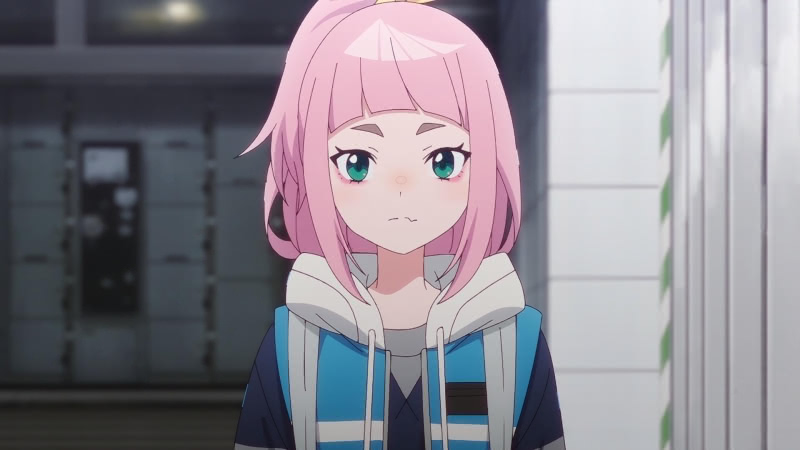
Kiui’s hair story is more straightforward than Kano’s and Mei’s but it nevertheless is relevant to her character arc.
Conclusion
While Jellyfish Can’t Swim in the Night has some focus and attention-to-detail issues, in the grand scheme of things it is a top-tier production in the area of hair color attention to detail. Not only do we see three characters undergo a combined four hair color transformations, but those hair color transformations are relevant to their character development and referenced as such by the characters themselves.
Kano’s hair was dyed black from brown to fit a certain image as an idol. Once Kano was forced off the stage, she chose a very unusual hair color scheme – which I believe was inspired by the mural that in turn inspired her to continue writing songs and singing. Kano matched A Sign of Affection’s Shin Iryuu, a stylish hair-stylist in training, for number of hair color depictions between the present and flashbacks.
Mei’s auburn hair was one of multiple reasons she was ostracized in music school. She dyed her hair black so she could be more like the person – Kano as the idol Nonoka – who gave her confidence in a dark time. Little did Mei know that Kano’s natural hair color was not actually black. Their hair colors were significant in their initial meeting in the show. Mei recognized Kano’s “bleached” hair as a sign that she had turned her back on her idol persona. Mei’s dramatic hair color change caused Kano to initially not recognize her at all.
(The handling of Mei’s hair color was clever enough to make me almost forgive the fact that she is the shakiest character in terms of writing quality in the main group.)
Kiui’s hair color story is the most straightforward and a reasonably astute girl should be able to put her situation together well before the explicit episode 3 reveal. But Kiui’s transformation is handled well and I appreciated that having Kano and Mei react positively to seeing Kiui’s hair in their first meeting played a subtle role in Kiui opening up to them.
I will conclude by noting that there is one additional character worthy of hair color study – albeit she is tangential to the main four characters and only plays a significant role (thus far) in episode 6. However, I decided to limit my focus to the main cast because the show does not say anything definitive about the hair color of this character and discussing her episode 6 story is not worth the minor spoiler given the lack of definitive hair color context.
Between the excellent A Sign of Affection in the winter 2024 season and Jellyfish Can’t Swim in the Night, 2024 has been a banner year for hair color in anime thus far. (Hair color plays a role in another spring 2024 series, a delinquent anime called Wind Breaker, although I will not discuss that series in article form because its hair color discussion is not particularly interesting.) I dare say 2024 has already been a great year for anime hair color studies without more, but perhaps there will be more to come as we look forward to the summer and fall seasons.
